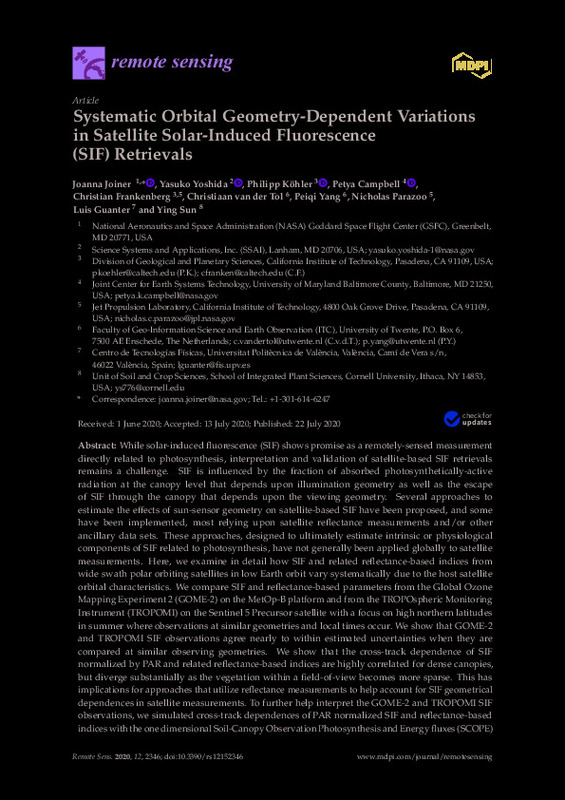Joiner, J.; Yoshida, Y.; Köhler, P.; Campbell, P.; Frankenberg, C.; Van Der Tol, C.; Yang, P.... (2020). Systematic Orbital Geometry-Dependent Variations in Satellite Solar-Induced Fluorescence (SIF) Retrievals. Remote Sensing. 12(15):1-29. https://doi.org/10.3390/rs12152346
Por favor, use este identificador para citar o enlazar este ítem: http://hdl.handle.net/10251/192986
|
Título:
|
Systematic Orbital Geometry-Dependent Variations in Satellite Solar-Induced Fluorescence (SIF) Retrievals
|
|
Autor:
|
Joiner, Joanna
Yoshida, Yasuko
Köhler, Philipp
Campbell, Petya
Frankenberg, Christian
van der Tol, Christiaan
Yang, Peiqi
Parazoo, Nicholas

 Guanter-Palomar, Luis María
Sun, Ying
Guanter-Palomar, Luis María
Sun, Ying
|
|
Entidad UPV:
|
Universitat Politècnica de València. Escuela Técnica Superior de Ingenieros de Telecomunicación - Escola Tècnica Superior d'Enginyers de Telecomunicació
|
|
Fecha difusión:
|
|
|
Resumen:
|
[EN] While solar-induced fluorescence (SIF) shows promise as a remotely-sensed measurement directly related to photosynthesis, interpretation and validation of satellite-based SIF retrievals remains a challenge. SIF is ...[+]
[EN] While solar-induced fluorescence (SIF) shows promise as a remotely-sensed measurement directly related to photosynthesis, interpretation and validation of satellite-based SIF retrievals remains a challenge. SIF is influenced by the fraction of absorbed photosynthetically-active radiation at the canopy level that depends upon illumination geometry as well as the escape of SIF through the canopy that depends upon the viewing geometry. Several approaches to estimate the effects of sun-sensor geometry on satellite-based SIF have been proposed, and some have been implemented, most relying upon satellite reflectance measurements and/or other ancillary data sets. These approaches, designed to ultimately estimate intrinsic or physiological components of SIF related to photosynthesis, have not generally been applied globally to satellite measurements. Here, we examine in detail how SIF and related reflectance-based indices from wide swath polar orbiting satellites in low Earth orbit vary systematically due to the host satellite orbital characteristics. We compare SIF and reflectance-based parameters from the Global Ozone Mapping Experiment 2 (GOME-2) on the MetOp-B platform and from the TROPOspheric Monitoring Instrument (TROPOMI) on the Sentinel 5 Precursor satellite with a focus on high northern latitudes in summer where observations at similar geometries and local times occur. We show that GOME-2 and TROPOMI SIF observations agree nearly to within estimated uncertainties when they are compared at similar observing geometries. We show that the cross-track dependence of SIF normalized by PAR and related reflectance-based indices are highly correlated for dense canopies, but diverge substantially as the vegetation within a field-of-view becomes more sparse. This has implications for approaches that utilize reflectance measurements to help account for SIF geometrical dependences in satellite measurements. To further help interpret the GOME-2 and TROPOMI SIF observations, we simulated cross-track dependences of PAR normalized SIF and reflectance-based indices with the one dimensional Soil-Canopy Observation Photosynthesis and Energy fluxes (SCOPE) canopy radiative transfer model at sun-satellite geometries that occur across the wide swaths of these instruments and examine the geometrical dependencies of the various components (e.g., fraction of absorbed PAR, SIF yield, and escape of SIF from the canopy) of the observed SIF signal. The simulations show that most of the cross-track variations in SIF result from the escape of SIF through the scattering canopy and not the illumination.
[-]
|
|
Palabras clave:
|
Solar-induced fluorescence
,
Satellite remote sensing
,
SIF
,
Reflectance
,
GOME-2
,
TROPOMI
,
BRDF
,
LAI
,
Leaf area index
,
Bidrectional reflectance
|
|
Derechos de uso:
|
Reconocimiento (by)
|
|
Fuente:
|
Remote Sensing. (issn:
2072-4292
)
|
|
DOI:
|
10.3390/rs12152346
|
|
Editorial:
|
MDPI AG
|
|
Versión del editor:
|
https://doi.org/10.3390/rs12152346
|
|
Código del Proyecto:
|
info:eu-repo/grantAgreement/NASA//80NSSC18K0337/
info:eu-repo/grantAgreement/NASA//80NSSC19M0110/
|
|
Agradecimientos:
|
This work was supported by the NASA Making Earth System Data Records for Use in Research Environments (MEaSUREs), Earth Science US Participating Investigator (ESUSPI), and Arctic-Boreal Vulnerability Experiment (ABoVE) and ...[+]
This work was supported by the NASA Making Earth System Data Records for Use in Research Environments (MEaSUREs), Earth Science US Participating Investigator (ESUSPI), and Arctic-Boreal Vulnerability Experiment (ABoVE) and Multi-Source Land Imaging (MuSLI) programs, specifically grants ABoVE 80NSSC19M0110 and MuSLI 80NSSC18K0337. PY was funded by the Netherlands Organization for Scientific Research (NWO), project ALWGO.2018.018.
[-]
|
|
Tipo:
|
Artículo
|









